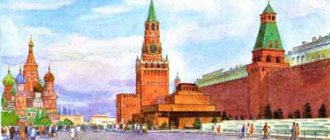Didactic game "Toys"
Dolls have existed for centuries; they are the best means of comprehensive development and socialization of children. Therefore, no kindergarten can do without a large play corner.
The purpose of the didactic game “Toys” is to get acquainted with different dolls and toys, to develop the ability to distinguish between them based on their main characteristics.
Tasks:
- formation of ideas about the types of toys, their size, geometric shape, color, number;
- enrichment of vocabulary on the topic “Children’s toys”;
- education of careful handling of toy objects;
- developing the ability to think logically and concentrate;
- improvement of finger motor skills, general coordination of movements, spatial orientation;
- development of speech skills, the ability to communicate, build a dialogue, listen to the interlocutor, answer questions, describe objects;
- development of imagination, visual perception.
Drawn pictures
For the formation of a passive vocabulary, pictures for children depicting various toys are of great importance. It is very good if they are presented in a wide variety, this allows you to offer the child many different speech exercises and activities.
For speech therapy games, it is much more convenient to use cards rather than real objects. Sorting and describing images not only contributes to children’s speech development, but also improves them:
- visual-figurative thinking;
- RAM;
- attention.
Of course, it is very difficult to draw such pictures yourself; it is better to find ready-made ones selected by professional speech therapists.
Progress of the game
There are several options for exciting didactic games on the topic “Toys”.
Dollhouse
To play, you need to make a doll's house and pieces of furniture from scrap materials. The activity develops creative thinking, with its help children learn where what furniture should be in the home, learn to behave correctly in the house, and consolidate knowledge about sides and angles.
Pupils look at the doll's house, arrange the furniture in the way they think is most correct and comfortable. At the same time, they say, for example, “the closet should be in the left corner of the bedroom on the second floor,” let’s put the dining table in . The teacher simultaneously asks why the children chose this arrangement and why they think it is correct.
Dress up the doll
In the younger group, you can play a competitive game, take two or more dolls of the same size with similar clothes. There are as many players as there are dolls. The rest of the children cheer for their playing classmates.
The game, depending on the number of dolls, can be played in pairs, or in several rounds with elimination. The most dexterous one wins.
Fix the toy
The teacher prepares pictures depicting different toys. Cuts into several parts. The players’ task is to “fix” the image and connect its parts.
Find the shadow
To play the game, you need to prepare pictures depicting different toy objects, and pictures with similar silhouettes of these objects. The players' task is to make pairs of pictures.
Pick up a toy
The teacher shows the children geometric shapes - circle, oval, square, rectangle, triangle. During the didactic game, the players try to determine which toy is similar to each of the figures.
Who's wearing what?
For the didactic game “Toys” in the younger group, you need to take several dolls that differ in clothing and appearance. Having arranged them, the teacher asks “who has a red sundress,” “who has white socks,” “who has blond hair,” “who has blue eyes,” and so on. Children point to the corresponding dolls.
What disappeared
The following game is suitable for the average group of preschoolers: the teacher puts several toys on the table, the children remember them and close their eyes. The teacher removes one item. Children, opening their eyes, try to remember which object disappeared.
Who wants what?
The teacher puts three balls of different sizes, next to them puts three dolls (or three cars, or three teddy bears), also different in size. The task is to distribute objects in pairs and determine how they compare in size.
Similarly, you can distribute objects by color. For example, take red, yellow, blue balls and dolls in similar colored dresses.
Describe the toy
For playing in the older group, the teacher chooses several toys that differ in appearance. Children are divided into groups. Participants take turns naming a feature that characterizes the object chosen by their group.
For example:
- doll - beautiful, large, fair-haired, elegant, smiling, blue-eyed;
- teddy bear - teddy, brown, soft, kind, cute, cheerful;
- The machine is plastic, small, fast, smooth, shiny.
The group that names the most features wins. The game develops the ability to match adjectives to nouns.
Coloring pages
To conduct classes on the topic “Toys” it is also very useful to use thematic coloring books. They help the child not only learn and remember all kinds of names of objects for games, but also practice using a large number of descriptive adjectives (in descriptions of various colors and materials). A correctly selected coloring book is a real helper for speech therapists and parents!



